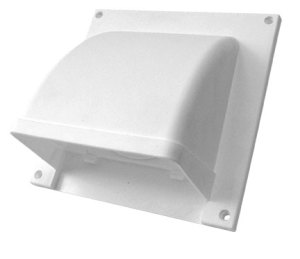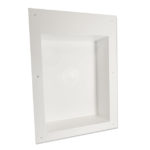 Clothes dryer exhaust vents are likely one of the riskiest construction elements contained in a home. In the United States, they are responsible for more than 12,000 fires every year. The combination of lint and high temperatures can spell disaster, often with few obvious warning signs.
Clothes dryer exhaust vents are likely one of the riskiest construction elements contained in a home. In the United States, they are responsible for more than 12,000 fires every year. The combination of lint and high temperatures can spell disaster, often with few obvious warning signs.
Proper airflow through an exhaust vent is key to preventing a dryer from overheating, and at the very least will improve efficiency and reduce energy costs. A well designed vent that avoids some common mistakes could save thousands of dollars in potential damage, and even someone’s life.
Dryer vent safety begins with choosing a safe place to locate a dryer. Many building codes limit the length of a dryer vent to 25 feet to ensure lint can be effectively cleared through the duct work. That likely means placing a dryer near an outer wall where duct runs to the outside can be kept relatively short, and multiple direction changes can be avoided.
Most dryers vent at the back of the unit, where a duct is attached. Choosing a safe material for that duct is vital. Just because it looks like shiny metal, it doesn’t necessarily mean it will help contain potential fires.
Flexible, vinyl or foil ducts are a poor choice. Not only does their ribbing create spots for lint to collect, but also the plastics and paper used to create them are highly flammable. If a lint fire sparks under high heat, they will quickly allow flames to spread.
Rigid, metal ducts are a much better choice. They provide a smooth interior that allows lint to pass without getting trapped. There are also flexible, metal options that maintain their rigidity, while allowing for some shaping to accommodate necessary twists and turns. Should disaster ever strike, these metal options will have the best chance of limiting damage to the inside of the duct and the dryer.
Fire dangers exist beyond the duct. Every exhaust vent requires some sort of outside cover. The outdoor wall cap can also be a source of problems. It provides another spot where lint can become trapped, and block the proper transfer of air.
Some vent hoods are equipped with screens to keep animals out. Those screens are not designed to cope with the lint produced by a dryer. They can become clogged, and eventually lead to dangerous overheating issues and subsequent fires. Other vent cap designs that use flaps provide much safer options.
Even the best exhaust vents should be cleaned at regular intervals to ensure a dryer is working efficiently, and not posing unnecessary threats. Still, regular maintenance can’t fix fundamental design problems. Builders have the best opportunity to make dryer vents safe from the start. As a professional, creating a home with a carefully considered dryer exhaust vent should be a fundamental part of any project.



